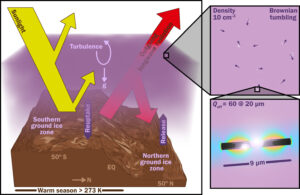A new idea among a rich history of proposals to make the surface of the cold planet habitable

A team including Northwestern researchers has proposed a revolutionary approach toward terraforming Mars using engineered dust particles. Image by NASA/JPL/MSSS
Ever since learning the surface of the planet Mars is cold and dead, scientists have wondered if there was a way to make it friendlier to life.
In a groundbreaking study published Aug. 7 in Science Advances, researchers from Northwestern University, University of Chicago and University of Central Florida have proposed a revolutionary approach toward terraforming Mars. This new method, using engineered dust particles released into the atmosphere, could potentially warm the Red Planet by more than 50 degrees Fahrenheit, to temperatures suitable for microbial life — a crucial first step toward making Mars habitable.
The proposed method is more than 5,000 times more efficient than previous schemes to globally warm the planet, representing a significant leap forward in our ability to modify the Martian environment, according to lead author and Northwestern electrical and computer engineering graduate student Samaneh Ansari, who works in the lab of Northwestern professor Hooman Mohseni. Mohseni, is a study co-author, the AT&T Professor of Information Technology at Northwestern’s McCormick School of Engineering, a professor of physics and astronomy in the Weinberg College of Arts and Sciences and a core faculty member of the Center for Interdisciplinary Exploration and Research in Astrophysics (CIERA),
What sets this approach apart is its use of resources readily available on Mars, making it far more feasible than earlier proposals that relied on importing materials from Earth or mining rare Martian resources.
This strategy would take decades. But it appears logistically easier than other plans proposed so far, the researchers said.
“This suggests that the barrier to warming Mars to allow liquid water is not as high as previously thought,” said Edwin Kite, an associate professor of geophysical sciences at the University of Chicago and corresponding author on the study.
Making the planet suitable for humans to walk on the surface unaided requires much more work — astronauts still won’t be able to breathe Mars’ thin air. But perhaps groundwork could be laid by making the planet habitable for microbes and food crops that could gradually add oxygen to the atmosphere, much as they have done for Earth during its geologic history.

CIERA Professor Aaron Geller also contributed to the research, creating Figure 3 in the paper (above): a depiction of the proposed nanoparticle-warming process.
Continue to the full Northwestern news article.

